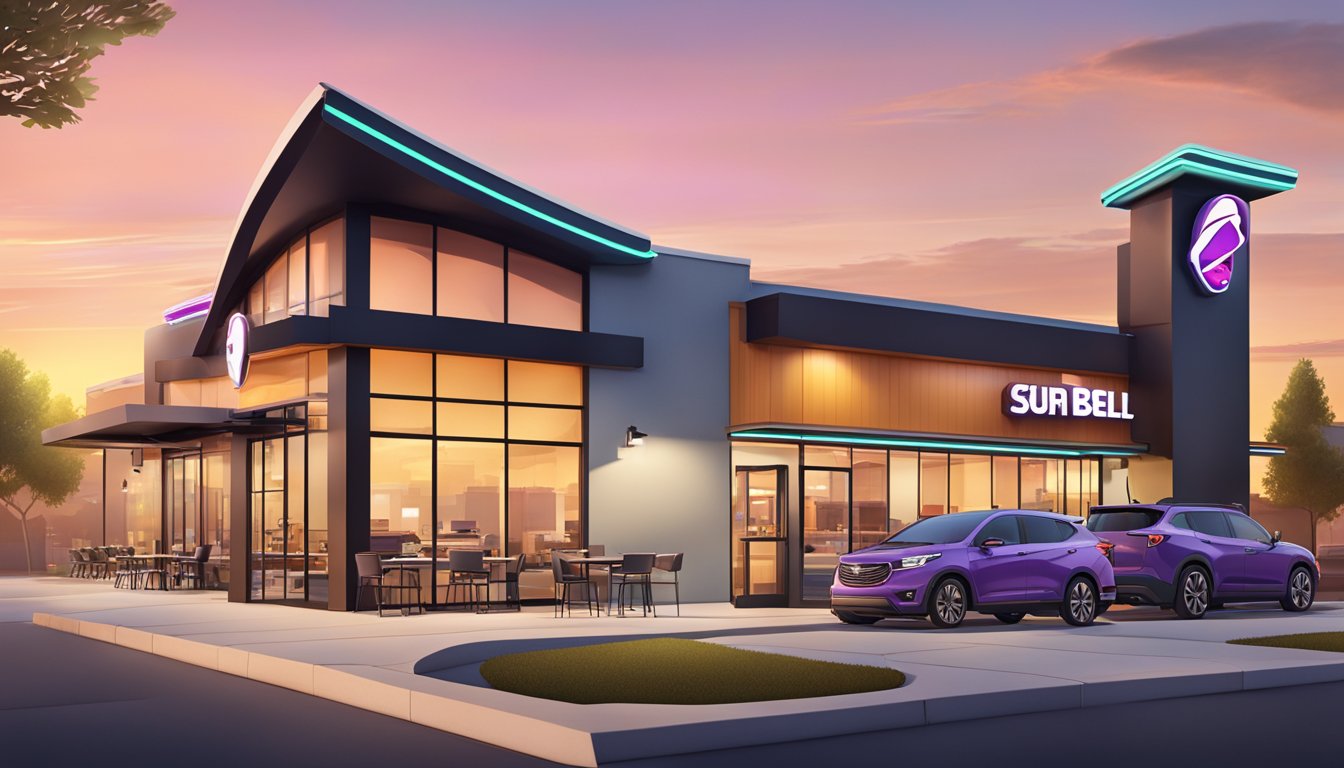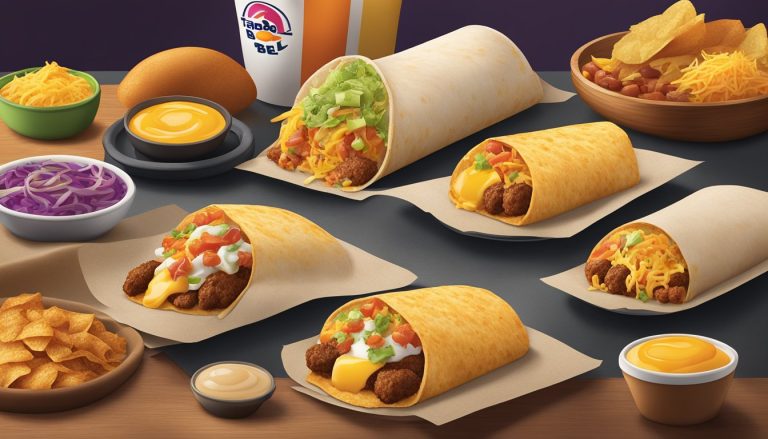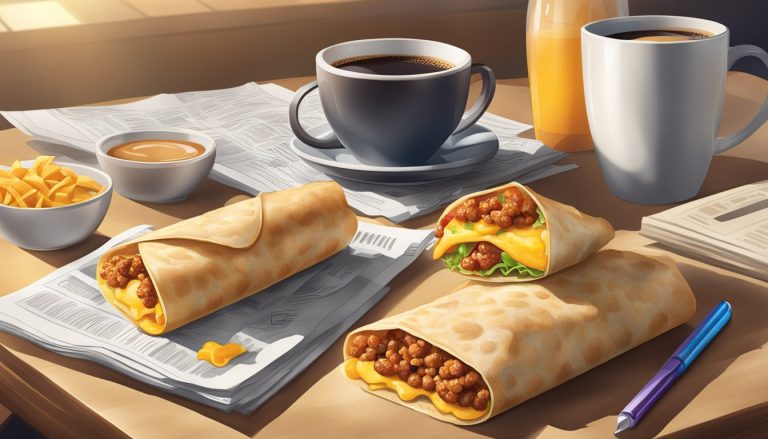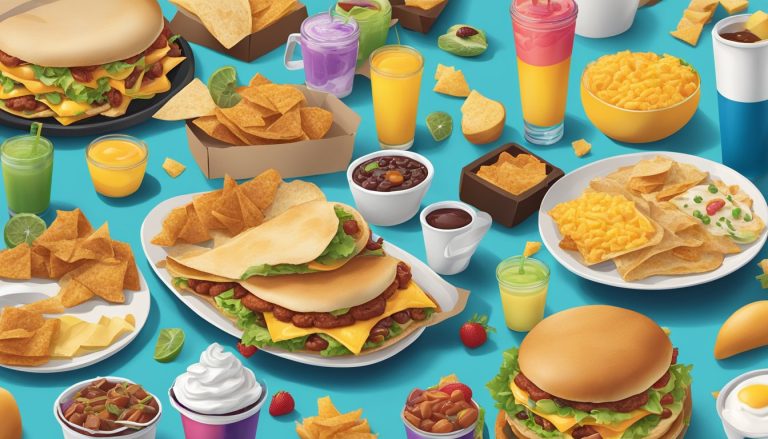Taco Bell revolutionized the fast food breakfast scene on March 27, 2014, with the launch of its innovative morning menu. The introduction of unique items like the Waffle Taco and Crunchwrap challenged traditional breakfast norms, offering customers bold and flavorful options to start their day.
Taco Bell’s breakfast menu launch marked a significant shift in the fast food industry, expanding the chain’s offerings beyond its signature Mexican-inspired fare. This move not only diversified Taco Bell’s menu but also positioned the brand as a formidable competitor in the lucrative breakfast market.
The evolution of Taco Bell’s restaurant design has been equally noteworthy. From its distinctive Mission-style architecture in the 1970s to the postmodern interiors of the 1980s and 1990s, Taco Bell’s physical spaces have undergone significant transformations. These design changes reflect broader trends in fast food aesthetics and consumer preferences, showcasing the brand’s adaptability in a rapidly changing industry.
The Dawn of Taco Bell

Taco Bell’s inception marked a pivotal moment in fast-food history. Glen Bell’s journey from hot dog stands to Mexican-inspired cuisine set the stage for a revolutionary dining concept.
Glen Bell’s Visionary Beginnings
Glen Bell, a former Marine, entered the food industry with ambition and innovation. In the 1940s, he opened his first hot dog stand in San Bernardino, California. Bell’s entrepreneurial spirit drove him to experiment with new menu items and business models.
He observed the popularity of Mexican restaurants in his area, particularly noting their efficient taco preparation methods. This sparked an idea that would eventually lead to the creation of Taco Bell.
From Hot Dog Stand to Taco Tia
Inspired by local Mexican eateries, Bell began incorporating tacos into his hot dog stand menu. He developed a hard-shell taco that could be prepared quickly, a key innovation for fast-food service.
In 1954, Bell opened his first taco-centric restaurant called Taco Tia. The success of this venture encouraged him to expand. He later sold Taco Tia and started a new chain called El Taco.
Bell’s experience with these restaurants refined his concept for a Mexican-inspired fast-food establishment.
Birth in Downey, California
On March 21, 1962, Glen Bell opened the first Taco Bell restaurant in Downey, California. This modest 400-square-foot building became the birthplace of a fast-food empire.
The original menu was simple, featuring tacos, burritos, frijoles, chiliburgers, and tostadas. Tacos sold for just 19 cents each.
Taco Bell’s unique offering of Mexican-inspired fast food quickly gained popularity. The concept resonated with customers seeking affordable, flavorful alternatives to traditional burger joints.
Within two years, Bell opened eight more locations in the Los Angeles area, setting the stage for rapid expansion across the United States.
Rise of Mexican-Inspired Fast Food

Taco Bell pioneered Mexican-inspired fast food in the United States, sparking a trend that reshaped the quick-service restaurant landscape. The chain’s success led to increased popularity of tacos, burritos, and other Mexican-influenced menu items across the country.
Tacos and Burritos Take On Burgers
In the 1960s and 1970s, Taco Bell’s rapid expansion challenged the dominance of burger-centric fast food chains. The company’s growth from a single location in Downey, California to hundreds of restaurants nationwide demonstrated the appeal of Mexican-inspired cuisine. Tacos and burritos offered a novel alternative to traditional hamburgers and fries. This shift in consumer preferences prompted other fast food chains to incorporate Mexican-inspired items into their menus.
Diversifying the Menu With Bold Flavors
Taco Bell’s success encouraged the introduction of bolder flavors in fast food. The chain expanded its menu beyond basic tacos and burritos to include items like quesadillas, nachos, and Mexican pizzas. These additions showcased spicier seasonings and unique ingredient combinations. Other restaurants followed suit, incorporating Mexican-inspired flavors and dishes into their offerings. This diversification helped broaden the American palate and create new expectations for fast food variety.
Numero Uno and Pepsico Era
In 1978, Taco Bell was acquired by PepsiCo, marking a significant turning point for the brand. This partnership provided resources for further expansion and menu innovation. The acquisition also led to the creation of Taco Bell’s “Numero Uno” restaurant design, featuring a distinctive adobe-style architecture. This iconic look became synonymous with the brand and helped establish Taco Bell’s visual identity. Under PepsiCo’s ownership, Taco Bell continued to grow, solidifying its position as a major player in the fast food industry and further popularizing Mexican-inspired cuisine across the United States.
Advancing the Fast Food Experience

Taco Bell leads the charge in transforming fast food with innovative drive-thru designs, playful restaurant concepts, and expanded menu options. These advancements cater to changing consumer preferences and enhance the overall dining experience.
Drive-Thru Innovation and Design
Taco Bell’s “Go Mobile” concept revolutionizes the drive-thru experience. Launched in 2020, this streamlined design features dual drive-thru lanes and smart kitchen technology. The compact 1,325 square foot layout prioritizes efficiency and digital integration.
“Bellhops” equipped with tablets take orders in-line, speeding up service. Dedicated pickup lanes for mobile orders further reduce wait times. This design optimizes space while increasing throughput.
Taco Bell’s futuristic “Defy” prototype takes innovation even further. This gravity-defying concept elevates the kitchen above four drive-thru lanes. Food is delivered via vertical lifts, creating a seamless and contactless experience.
Bringing Fun to Fast Food
Taco Bell injects excitement into fast food with its “Cantina” concept. These locations offer a “fast social” dining experience, blending quick service with a vibrant atmosphere.
Cantinas feature open kitchens and digital menu boards. Shareable appetizers encourage group dining. Some locations even serve alcoholic beverages, including beer and twisted freezes.
Interactive touchscreen kiosks allow for customized ordering. Eye-catching artwork and modern decor create an inviting ambiance. These design elements transform Taco Bell from a mere pit stop into a destination for casual gatherings.
Expansion of Vegetarian Options
Taco Bell leads the industry in vegetarian-friendly fast food options. In 2019, the chain introduced a dedicated vegetarian menu, featuring items certified by the American Vegetarian Association.
Plant-based proteins like black beans and refried beans serve as meat substitutes. The “Veggie Power Menu Bowl” offers a hearty, nutrition-focused option.
Taco Bell’s “Make it Meatless” feature allows easy customization of any menu item. This flexibility caters to vegetarians, vegans, and flexitarians alike. The chain continues to innovate, testing new plant-based proteins to expand its vegetarian offerings.
Breakfast Revolution at Taco Bell

Taco Bell shook up the fast food industry with its foray into breakfast in 2014. The chain introduced unique menu items that blended Mexican-inspired flavors with traditional morning fare, aiming to capture a share of the competitive breakfast market.
Launching the Breakfast Menu
Taco Bell officially launched its nationwide breakfast menu on March 27, 2014. This move marked a significant expansion for the brand, which had previously focused on lunch and dinner offerings. The launch was supported by Taco Bell’s largest marketing campaign to date, signaling the company’s commitment to this new venture.
The decision to enter the breakfast market was driven by the potential for growth and the opportunity to differentiate from competitors. Taco Bell aimed to attract younger consumers seeking alternatives to traditional breakfast options.
Iconic Breakfast Items
Taco Bell’s breakfast menu featured several innovative items that quickly gained popularity:
- Breakfast Crunchwrap: A tortilla filled with eggs, cheese, and choice of meat, wrapped around a hash brown
- Waffle Taco: A waffle folded and filled with eggs, cheese, and sausage or bacon
- Cinnabon Delights: Bite-sized pastries filled with Cinnabon frosting
These items combined familiar breakfast ingredients with Taco Bell’s signature style. The menu also included more traditional options like breakfast burritos and sandwiches to cater to a wider range of preferences.
Competing in the Breakfast Market
Taco Bell’s entry into the breakfast market posed a challenge to established players like McDonald’s and Burger King. The chain’s unique offerings and later serving hours (typically until 11 am) provided a competitive edge.
To stand out, Taco Bell emphasized its distinct flavor profiles and portable menu items suited for on-the-go consumption. The company also leveraged social media and targeted marketing campaigns to appeal to younger demographics.
Despite initial skepticism, Taco Bell’s breakfast offerings gained traction. By 2019, breakfast accounted for 6% of the chain’s overall sales, with plans for further growth in this segment.
Innovations in Service and Delivery

Taco Bell has embraced technological advancements to enhance customer experience and streamline operations. The company has implemented several key innovations that have transformed how customers order, receive, and enjoy their food.
The Rise of Delivery Services
Taco Bell partnered with major delivery platforms to expand its reach beyond traditional dine-in and drive-thru options. This move allowed customers to enjoy Taco Bell favorites from the comfort of their homes or offices.
The company optimized its menu for delivery, ensuring food quality and temperature are maintained during transit. Taco Bell also introduced specialized packaging to preserve food integrity during delivery.
To meet increased delivery demand, some Taco Bell locations added dedicated pickup areas for delivery drivers. This helped reduce wait times and improve efficiency for both in-store and delivery orders.
Mobile Ordering and Customer Convenience
Taco Bell’s mobile app revolutionized the ordering process. Customers can now customize their meals, pay in advance, and schedule pickup times through their smartphones.
The app features a user-friendly interface and remembers previous orders for quick reordering. It also offers exclusive deals and promotions to app users, incentivizing digital engagement.
Taco Bell implemented in-store kiosks for self-service ordering. These touch-screen stations allow customers to browse the menu, customize items, and pay without interacting with staff.
Redesigning for the Modern Consumer
Taco Bell’s “Cantina” concept represents a significant shift in restaurant design. These urban-focused locations offer a more upscale dining experience with open kitchens and digital menu boards.
Cantinas serve alcohol and feature shareable menu items, catering to a social dining atmosphere. The design incorporates modern aesthetics with flexible seating arrangements to accommodate various group sizes.
Traditional Taco Bell locations have also undergone renovations. Many now feature multiple drive-thru lanes to reduce wait times and handle increased order volume.
Digital menu boards in drive-thrus allow for dynamic pricing and promotional changes. Some locations have added dedicated lanes for mobile order pickup, further streamlining the service process.
Signature Menu Items and Experiences

Taco Bell’s iconic offerings have shaped fast food culture and created devoted fans. These signature items combine bold flavors, unique textures, and innovative concepts that set the brand apart.
Crunchwrap Supreme and Doritos Locos Tacos
The Crunchwrap Supreme revolutionized on-the-go eating with its hexagonal shape and layers of textures. Launched in 2005, it features a soft tortilla wrapped around a crunchy tostada shell, beef, nacho cheese sauce, lettuce, tomatoes, and sour cream.
Doritos Locos Tacos debuted in 2012, merging Taco Bell’s classic taco with Doritos flavored shells. The initial Nacho Cheese version was followed by Cool Ranch and Fiery varieties. This collaboration between Taco Bell and Frito-Lay sparked a trend of brand partnerships in fast food.
These items exemplify Taco Bell’s approach to menu innovation, combining familiar elements in unexpected ways to create craveable new offerings.
Mexican Pizza’s Cultural Impact
The Mexican Pizza holds a special place in Taco Bell’s menu history. Introduced in 1985, it features two crispy tortillas layered with beans, beef, pizza sauce, and melted cheese. Its unique construction and flavor profile made it a cult favorite.
When discontinued in 2020, fan outcry led to its return in 2022. This demonstrated the item’s cultural significance and Taco Bell’s responsiveness to customer feedback. The Mexican Pizza’s journey highlights how fast food items can become integral parts of popular culture.
Its vegetarian-friendly nature also made it popular among diverse dietary preferences, showcasing Taco Bell’s adaptability to changing consumer needs.
Mountain Dew Baja Blast – A Unique Flavor Pairing
Mountain Dew Baja Blast, created exclusively for Taco Bell in 2004, exemplifies successful beverage innovation in fast food. The tropical lime flavor was specifically designed to complement Taco Bell’s menu items.
Initially available only in Taco Bell restaurants, Baja Blast’s limited availability created a sense of exclusivity. Its popularity led to periodic retail releases, driving excitement among fans.
The drink’s distinctive teal color became instantly recognizable, further cementing its status as a Taco Bell signature. Baja Blast’s success demonstrates how custom beverage offerings can enhance brand identity and customer loyalty in the fast food industry.
Culinary Journey Through Taco Bell’s History
Taco Bell’s menu has undergone significant changes since its founding in 1962. The brand’s evolution reflects shifting consumer tastes and innovative product development.
Evolution of Taco Bell’s Tacos
The crunchy taco was Taco Bell’s original star. Introduced by founder Glen Bell, it featured a crispy corn tortilla shell filled with seasoned ground beef, lettuce, and cheese. This signature item set Taco Bell apart from traditional taco stands.
In the 1970s, Taco Bell expanded its offerings. The company added soft tacos and burritos to appeal to a wider audience. These new items maintained the core flavors while providing texture variety.
The 1980s saw the introduction of more substantial menu items. Taco Bell launched the Burrito Supreme and Mexican Pizza, combining familiar ingredients in novel ways.
The 1990s Taco Bell Transformation
The 1990s marked a period of bold innovation for Taco Bell. The chain introduced the Gordita in 1998, featuring a thick flatbread shell. This item bridged the gap between tacos and pitas, offering a unique texture.
1995 saw the debut of the Border Lights menu. This health-conscious line reduced fat content in popular items by 20%. While short-lived, it demonstrated Taco Bell’s willingness to experiment.
The Chalupa, launched in 1999, became an instant hit. Its fried flatbread shell provided a satisfying crunch and set the stage for future menu innovations.
A Look at Commemorative Milestones
Taco Bell has celebrated key moments in its history with special menu items. In 2012, the chain marked its 50th anniversary by introducing the Doritos Locos Taco. This collaboration merged Taco Bell’s classic taco with Doritos’ iconic nacho cheese flavor.
The company’s 60th anniversary in 2022 brought back fan favorites. The Mexican Pizza returned to menus after a two-year hiatus, sparking excitement among loyal customers.
Taco Bell has also commemorated cultural milestones. In 2001, they created a special burrito to celebrate the new millennium. These limited-time offerings showcase Taco Bell’s ability to stay culturally relevant.
Building the Brand and Franchise
Taco Bell’s rapid growth from a single taco stand to a global fast-food empire hinged on strategic franchising and brand development. The company cultivated strong franchisee relationships, maintained quality standards, and embarked on ambitious expansion in the 1970s.
Franchisee Relationships and Growth
Taco Bell’s franchise model empowered local entrepreneurs while ensuring brand consistency. The company offered comprehensive training programs and operational support to franchisees. This approach fostered loyalty and encouraged franchisees to open multiple locations.
Taco Bell’s franchise agreements balanced corporate control with franchisee autonomy. The company set strict quality standards but allowed flexibility in local marketing and community engagement.
By 1970, Taco Bell had 325 restaurants. The franchise system fueled rapid expansion, enabling the brand to enter new markets quickly and efficiently.
Quality, Consistency, and the Taco Bell Brand
Taco Bell prioritized quality and consistency across its growing network of restaurants. The company implemented rigorous food safety protocols and standardized cooking procedures.
Franchisees received detailed manuals covering every aspect of restaurant operations. Regular inspections ensured compliance with brand standards.
Taco Bell’s commitment to quality extended to ingredient sourcing. The company developed relationships with suppliers to maintain consistent flavor profiles across all locations.
Menu innovation became a hallmark of the Taco Bell brand. New items were thoroughly tested before nationwide rollout, balancing novelty with operational feasibility.
The 1970s: A Decade of Expansion
The 1970s marked a period of explosive growth for Taco Bell. By 1978, the chain boasted over 868 restaurants. This rapid expansion was fueled by increasing consumer demand for fast, affordable Mexican-inspired cuisine.
Taco Bell refined its restaurant design during this period. The company introduced drive-thru windows in 1975, capitalizing on Americans’ growing car culture.
Strategic market penetration characterized Taco Bell’s 1970s expansion. The company targeted suburban areas and college towns, establishing a strong presence in these key demographics.
Taco Bell went public in 1970, raising capital for further expansion. This move solidified its position as a major player in the fast-food industry.




